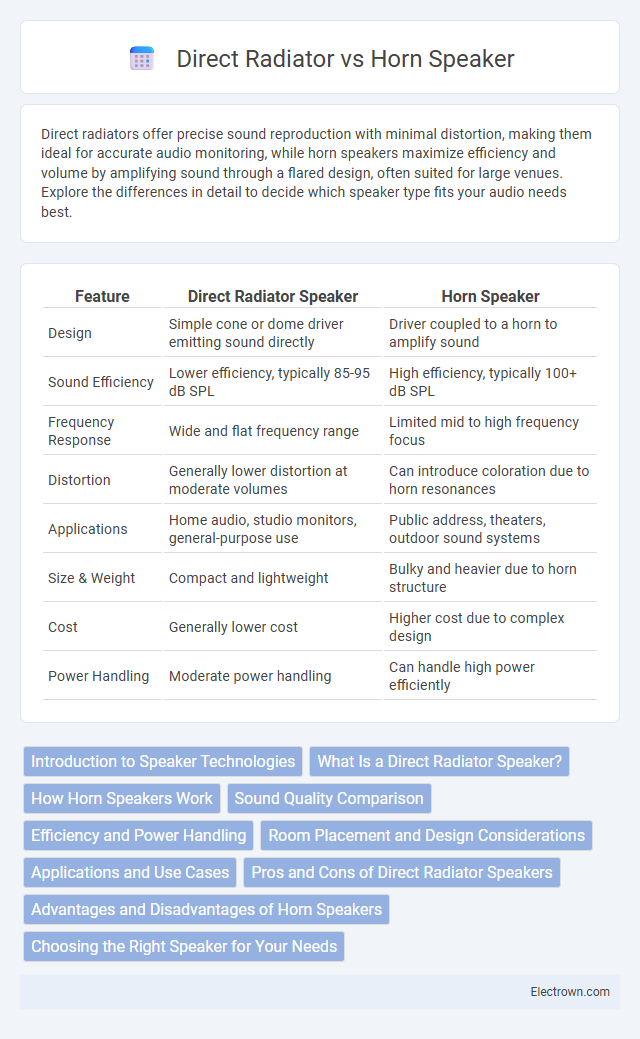Direct radiators offer precise sound reproduction with minimal distortion, making them ideal for accurate audio monitoring, while horn speakers maximize efficiency and volume by amplifying sound through a flared design, often suited for large venues. Explore the differences in detail to decide which speaker type fits your audio needs best.
Table of Comparison
| Feature | Direct Radiator Speaker | Horn Speaker |
|---|---|---|
| Design | Simple cone or dome driver emitting sound directly | Driver coupled to a horn to amplify sound |
| Sound Efficiency | Lower efficiency, typically 85-95 dB SPL | High efficiency, typically 100+ dB SPL |
| Frequency Response | Wide and flat frequency range | Limited mid to high frequency focus |
| Distortion | Generally lower distortion at moderate volumes | Can introduce coloration due to horn resonances |
| Applications | Home audio, studio monitors, general-purpose use | Public address, theaters, outdoor sound systems |
| Size & Weight | Compact and lightweight | Bulky and heavier due to horn structure |
| Cost | Generally lower cost | Higher cost due to complex design |
| Power Handling | Moderate power handling | Can handle high power efficiently |
Introduction to Speaker Technologies
Direct radiators convert electrical signals into sound through a moving diaphragm, delivering precise and natural audio reproduction ideal for most listening environments. Horn speakers utilize a flared horn to amplify sound waves, increasing efficiency and projecting audio over longer distances with higher volume. Understanding these fundamental differences can help you choose the right speaker technology based on your audio needs and space.
What Is a Direct Radiator Speaker?
A direct radiator speaker uses a cone or diaphragm connected directly to a voice coil, which moves air to produce sound without any additional acoustic horns. It is designed to emit sound waves directly from the cone, resulting in a more natural and accurate audio reproduction. This design contrasts with horn speakers, which use a flared horn to amplify and project sound, often enhancing efficiency but potentially altering tonal characteristics.
How Horn Speakers Work
Horn speakers operate by using a flared horn to amplify sound waves generated by a driver, efficiently matching the impedance between the source and the air for greater acoustic output. The horn shape controls the dispersion pattern, directing sound waves to cover a wider area with higher efficiency and reduced distortion compared to direct radiators. This design enables horn speakers to produce louder, clearer sound, making them ideal for large venues and outdoor applications.
Sound Quality Comparison
Direct radiators deliver precise, clear sound with deep bass response due to their full-range driver design, making them ideal for audiophiles seeking accurate audio reproduction. Horn speakers excel at efficiency and projecting sound over long distances, providing loud, dynamic output but sometimes sacrificing subtle audio details and natural tonal balance. The choice between direct radiator and horn speakers hinges on prioritizing sound fidelity versus volume and projection in various listening environments.
Efficiency and Power Handling
Direct radiators generally offer higher efficiency and better power handling, making them suitable for delivering robust sound at higher volumes without distortion. Horn speakers excel in projecting sound with greater sensitivity and directional control, allowing you to maximize output using less amplifier power. Choosing between the two depends on your specific needs for sound clarity, efficiency, and the intended use environment.
Room Placement and Design Considerations
Direct radiator speakers provide a more straightforward placement solution since their sound disperses widely and evenly, making them suitable for various room layouts and closer positioning to walls without significant sound degradation. Horn speakers require careful positioning to avoid directional sound issues and the resulting acoustic hotspots or dead zones, often benefiting from precise angling and more spacious room setups. Your choice between these speaker types greatly impacts room acoustics and aesthetic integration, influencing sound quality and overall listening experience.
Applications and Use Cases
Direct radiators excel in home audio systems and professional studio monitors due to their precise and balanced sound reproduction. Horn speakers are preferred in large venues, outdoor events, and public address systems because of their high efficiency and ability to project sound over long distances. The choice depends on the need for sound clarity in controlled environments versus maximum volume and coverage in expansive spaces.
Pros and Cons of Direct Radiator Speakers
Direct radiator speakers offer clear sound reproduction with precise imaging, making them ideal for critical listening environments. You may encounter limitations such as lower efficiency and less bass output compared to horn speakers, which can require more powerful amplification. Their compact design suits smaller spaces, but they might struggle to produce the dynamic range and volume levels that horn speakers achieve effortlessly.
Advantages and Disadvantages of Horn Speakers
Horn speakers provide high efficiency and superior sound projection, making them ideal for large venues and outdoor use where loud, clear sound is essential. Their design enables better impedance matching and controlled dispersion, resulting in enhanced audio clarity and lower distortion compared to direct radiators. However, horn speakers tend to be bulkier, more expensive, and can produce a harsh sound if not properly designed, limiting their suitability for casual indoor listening.
Choosing the Right Speaker for Your Needs
Direct radiators offer precise sound reproduction and are ideal for small to medium-sized rooms, while horn speakers deliver higher efficiency and greater volume, making them suitable for large venues or outdoor use. Your choice depends on the listening environment and volume requirements; direct radiators excel in clarity and warmth, whereas horn speakers provide powerful projection and dynamic range. Understanding these differences ensures you select the right speaker to enhance your audio experience.
direct radiator vs horn speaker Infographic

 electrown.com
electrown.com